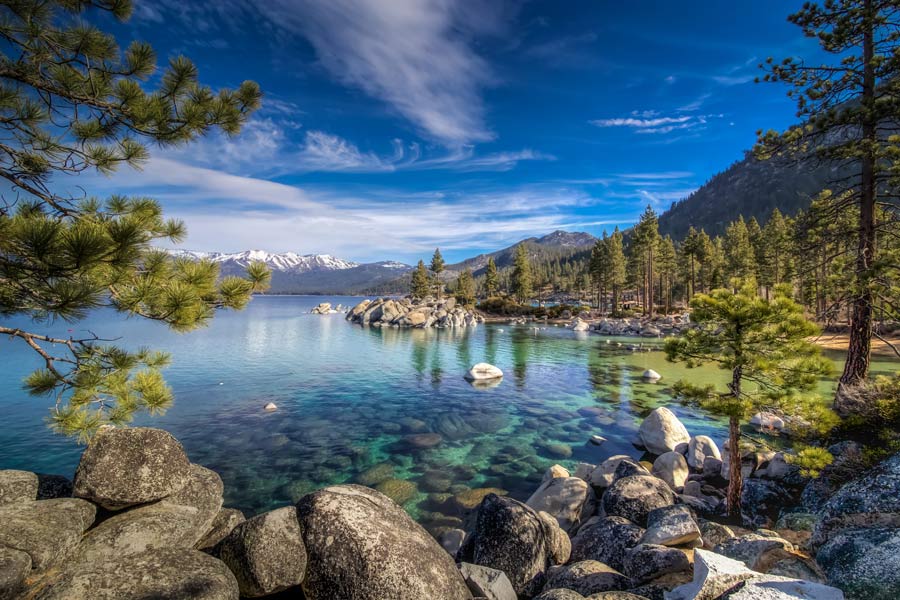Snowmelt this month in Lake Tahoe Basin will be massive and dangerous

Bill Rozak / Tahoe Daily Tribune
The Lake Tahoe Basin has about half of this year’s massive snowpack still stuck to the mountain slopes.
May was an extension of winter and the snowpack actually grew.
But June is here. Days are longer and temperatures are rising.
And that monster snowpack is about to come melting down the slopes through rivers and streams with ferocity, pushing an already fast water flow into a furious rage.
The swift, icy flow is going to make water recreation and hiking more dangerous as was recently seen at Lake Tahoe with a Bay Area woman being tragically swept over Eagle Falls in Emerald Bay. (Read more on Page 11.)
“Streams are still on the rise,” Jeff Anderson, a hydrologist for Natural Resources Conservation Service Nevada, told the Tribune on Tuesday. “We are only really getting warm temps again. I expect to see streamflow increase the first part of this week, especially on streams coming off the crest where there is significant snow to melt.”
2019 shaping up to be exactly like 2017
Anderson compares this year with 2017 when the Sierra had an even larger snowpack during peak winter. But in 2017 there was no May delay in the snowmelt so this year’s pack has caught up.
And late May and June 2017 proved to be dangerous.
A Minden woman, Stephanie Waggoner, 49, died after falling off her paddleboard in the Upper Truckee River.
She was experienced and wearing a life vest but was tethered to her board, which became hooked on a log. The leash dragged her underwater.
That was one week after South Lake Tahoe resident Elys Clark nearly drowned in the same river and recalled her harrowing fight for life in story published by the Tribune.
She described herself as an experienced kayaker and strong swimmer but the cold-shock response and raging river was almost more than she could take.
“My whole body just felt like it was burning. All I could do was gasp for air,” she said at the time.
Clark also said if she wasn’t wearing a life vest, she would be dead.
Later in June, also in the Upper Truckee, a kayaker whose vessel became pinned under a tree was fortunate when his yells for help were heard by an off-duty mechanic for the Lake Valley Fire Protection District.
The kayaker was apparently inverting his boat in order to squeeze underneath downed trees and floating debris before he got stuck, the Tribune previously reported.
More recently, the Placer County Sheriff’s Office reported a man went missing while swimming in the American River confluence near Auburn earlier this week.
And Mateo Rios, of Rocklin, is still missing after he was seen floating in distress last weekend down the South Fork of the American River near Chili Bar Park.
El Dorado County Swift Water Team Training Officer Tim Cannivarro was part of the team that went out and performed the initial search for Rios.
“The water is just too high this time of year and now we’re looking at a warmup,” Cannivarro said. “The water levels are going to rise, which means the shoreline will also rise becoming an extreme hazard. Any water-related search will now involve brush and not just rocks and sand.”
Cannivarro recalled a story about a young teenager playing alongside the Cosumnes River shoreline in 2017.
The teenager was swept away and it took nine months to recover his body.
“We are on heightened awareness this year, but we try to consistently be on high awareness,” said Cannivarro. “We try to keep the same level of awareness because sometimes in low snow years, people become less cautious.”
Wear a life vest
A man came floating down the Upper Truckee River on Wednesday afternoon on a short plastic kayak wearing no life vest, or personal flotation device (PFD), and appeared not to have one stowed anywhere.
It is a sight that makes all water rescuers cringe.
“Hands down the biggest thing people should use is a PFD,” Cannivarro said.
Not having life vests almost cost two people their lives Monday. They escaped with their lives but it did cost them some money.
Their metal canoe started taking on water during choppy conditions in the evening. They were saved by a private citizen who pulled them to safety, said Chris Fiore, communications manager for the city of South Lake Tahoe.
But the South Lake Tahoe Police Department and Nevada Department of Wildlife arrived shortly after and the pair were each issued a citation after it was discovered there was no PFD in the vessel or on their bodies.
“Lake Tahoe is a beautiful place but you have to be smart and safe,” Fiore said. “The mornings may be nice on the lake but once the wind kicks up in the afternoon, it gets rough. You have to know your own limitations, don’t take risks and take proper precautions.”
Hopefully falling off, or out of, a vessel unexpectedly never happens.
But if it does, having a life vest also helps battle cold shock response — a gasp reflex that can include hyperventilation and muscle spasms that can result in water inhalation and drowning can happen in seconds.
A PFD helps to stay afloat in the ice-melt water, and hopefully a little more calm, while fighting for breath and struggling to reach the shoreline.

Support Local Journalism

Support Local Journalism
Readers around the Lake Tahoe Basin and beyond make the Tahoe Tribune's work possible. Your financial contribution supports our efforts to deliver quality, locally relevant journalism.
Now more than ever, your support is critical to help us keep our community informed about the evolving coronavirus pandemic and the impact it is having locally. Every contribution, however large or small, will make a difference.
Your donation will help us continue to cover COVID-19 and our other vital local news.






